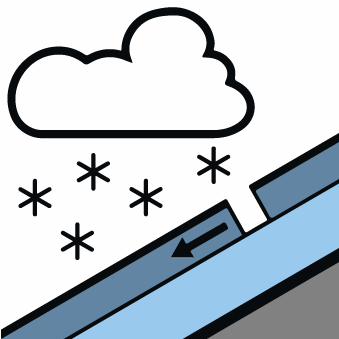
Danger level

2100m
Avalanche Problem

Wind-drifted snow

2100m


New snow

1600m


Fresh and somewhat older wind slabs represent the main danger.
The new snow can be released easily or naturally in all aspects above approximately 1800 m. In isolated cases the avalanches are medium-sized and can be released by a single winter sport participant.
The fresh wind slabs are lying on the unfavourable surface of an old snowpack in particular on shady slopes at high altitudes and in high Alpine regions. The avalanche-prone wind slabs of last week are covered with new snow and therefore difficult to recognise. The avalanche prone locations are to be found on steep northwest, north and northeast facing slopes above approximately 2000 m and adjacent to ridgelines and in gullies and bowls. In many cases the avalanches in these loacations are medium-sized.
The avalanche prone locations are barely recognisable because of the poor visibility. Backcountry touring and other off-piste activities call for extensive experience in the assessment of avalanche danger.
The fresh wind slabs are lying on the unfavourable surface of an old snowpack in particular on shady slopes at high altitudes and in high Alpine regions. The avalanche-prone wind slabs of last week are covered with new snow and therefore difficult to recognise. The avalanche prone locations are to be found on steep northwest, north and northeast facing slopes above approximately 2000 m and adjacent to ridgelines and in gullies and bowls. In many cases the avalanches in these loacations are medium-sized.
The avalanche prone locations are barely recognisable because of the poor visibility. Backcountry touring and other off-piste activities call for extensive experience in the assessment of avalanche danger.
Snowpack
>
Over a wide area 20 to 30 cm of snow, and up to 40 cm in some localities, has fallen since Thursday above approximately 1800 m. 5 to 10 cm of snow will fall from midday above approximately 2000 m.
The fresh and older wind slabs are lying on unfavourable layers on wind-protected shady slopes and at intermediate and high altitudes. Snow profiles and field observations confirm the unfavourable bonding of the snowpack on shady slopes. The old snowpack remains well bonded on sunny slopes.
Above approximately 2000 m there are 130 to 220 cm of snow. At high altitudes and in high Alpine regions snow depths vary greatly, depending on the infuence of the wind.
The fresh and older wind slabs are lying on unfavourable layers on wind-protected shady slopes and at intermediate and high altitudes. Snow profiles and field observations confirm the unfavourable bonding of the snowpack on shady slopes. The old snowpack remains well bonded on sunny slopes.
Above approximately 2000 m there are 130 to 220 cm of snow. At high altitudes and in high Alpine regions snow depths vary greatly, depending on the infuence of the wind.
Tendency
Significant increase in danger of moist avalanches as a consequence of warming.